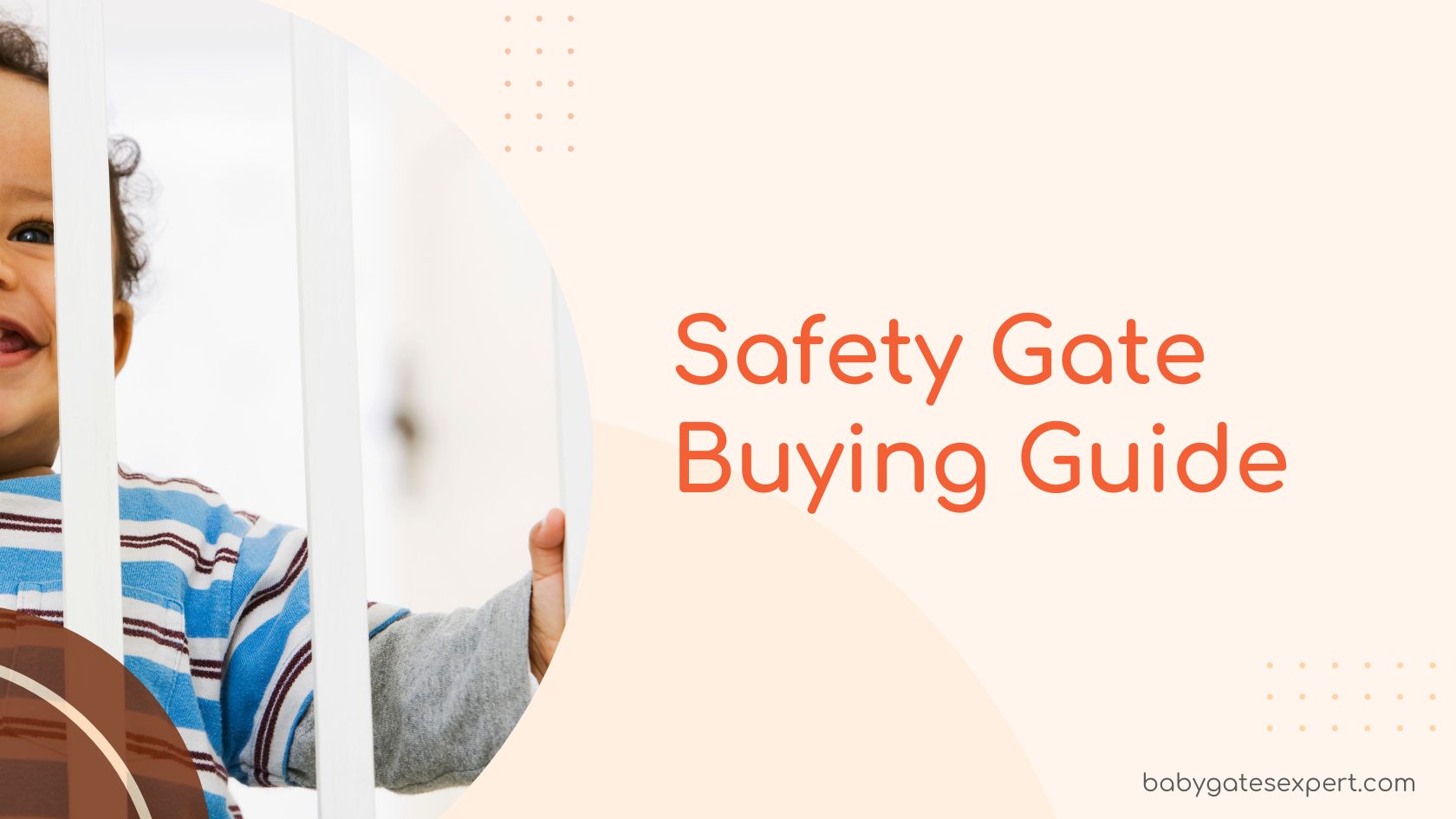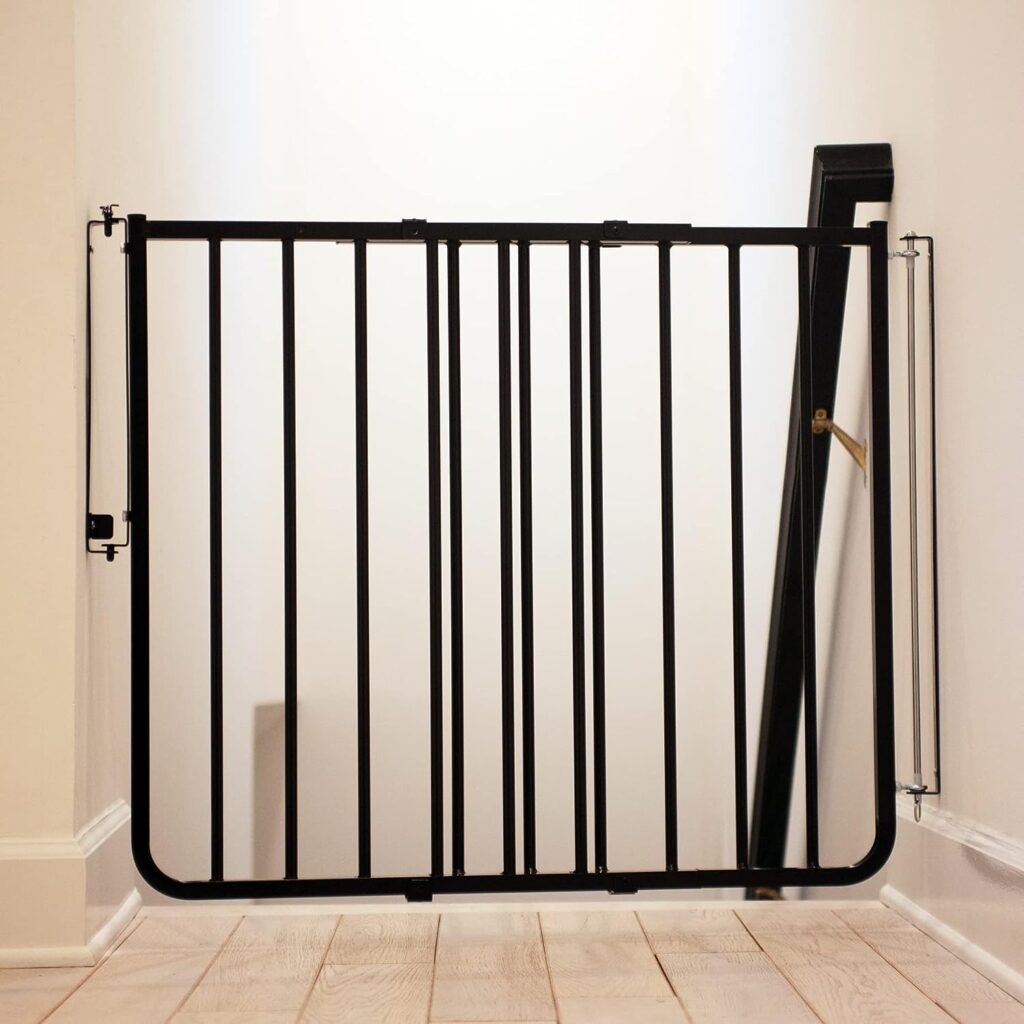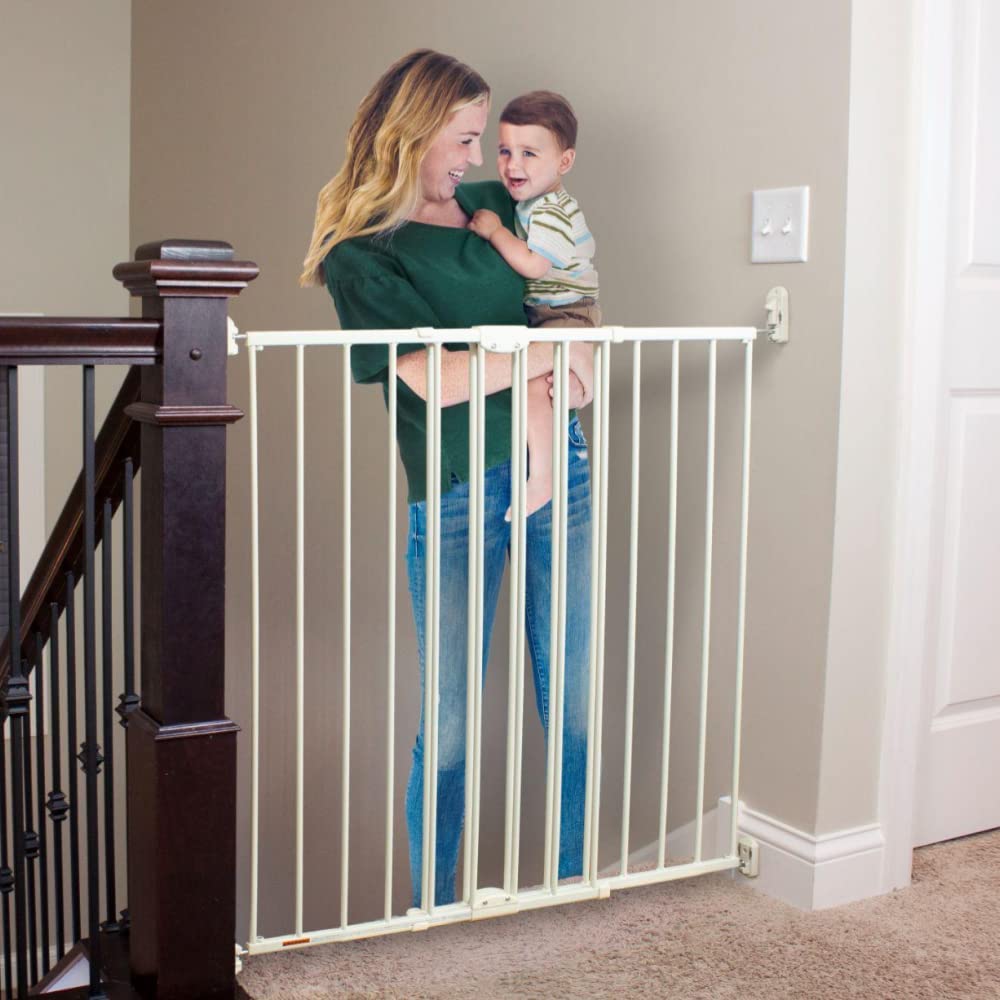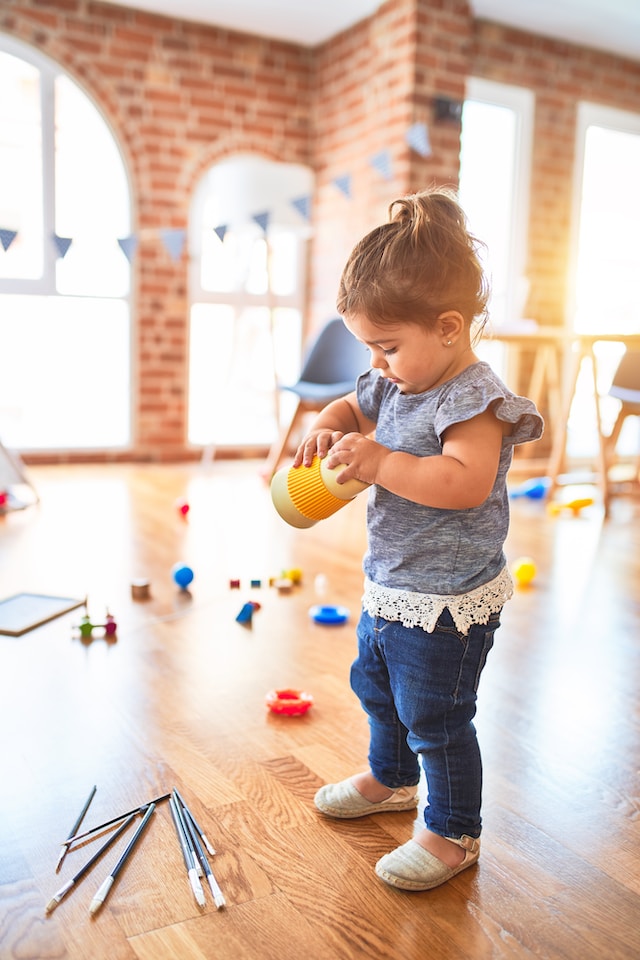In the ever-evolving journey of parenthood, ensuring the safety of your little ones is a paramount concern. Safety gates stand as protectors, offering a simple yet effective solution to prevent accidents and ensure a secure environment. Whether shielding curious toddlers or keeping mischievous pets at bay, choosing the right safety gate requires careful consideration of many factors. This comprehensive safety gate buying guide will navigate you through the maze of options, empowering you to make an informed decision that suits your unique needs.
Baby Safety Gates
Also referred to as a baby gate, a safety gate serves as a precaution against potential harm your child might undertake when your attention wanes.
Strategically positioning a safety gate can simplify the task of childcare by effectively blocking your child from potential hazards—think of staircases or zones in your home that might pose risks. A kitchen in active use or a bathroom housing medicines can be especially unsafe for toddlers. Notably, apart from ensuring the safety of children, these versatile safety gates (baby gates) can also serve as a containment solution for smaller pets like dogs.
The market offers safety gates at various price points, with offerings starting at roughly $50 for a wooden safety gate and scaling up to over $200 for a hybrid hardware-mounted safety gate for stairs equipped with user-friendly open-close functionalities.
These gates are typically engineered with children between 6 months and 3 years in mind. However, it’s crucial to recognize that once a child masters the skill of gate-opening or conquers the feat of scaling over it, the gates’ reliability as a safety measure diminishes. Remember, no matter how secure a gate may seem, it can never replace the importance of vigilant supervision when it comes to your baby or toddler. The cardinal rule prevails: never, under any circumstances, should you leave your child unattended.
Understanding Safety Gate Types
Pressure-Mounted Gates
These gates employ pressure to stay in place, eliminating the need for tools or drilling. Best suited for areas where you require temporary confinement, like between rooms or at the bottom of stairs. They are versatile and easy to install, making them a convenient choice for rental homes.
Hardware-Mounted Gates
For areas that necessitate a more robust and permanent barrier – think stairways or other hazardous zones – hardware-mounted gates are your go-to. These gates are securely fastened to walls using screws and brackets, ensuring stability and reliability.
Freestanding Gates
If you’re seeking a gate that doesn’t require installation, freestanding gates are the answer. These gates stand independently and can be placed wherever you need them. They’re particularly handy for creating play zones or blocking off wider openings.
Key Factors to Consider When Choosing a Safety Gate
Location and Purpose
The initial step in selecting a safety gate is defining its purpose. Safety gates serve a variety of functions, ranging from keeping curious toddlers away from staircases to containing energetic pets. By pinpointing the precise areas in your home that demand gating, such as top or bottom of stairs, doorways, or specific rooms, you lay the groundwork for an effective selection process. Each location may necessitate a different type of gate, tailored to the unique demands of that space.
Gate Height and Climbing Deterrence
The height of the safety gate is a pivotal consideration with profound implications. Not only does it dictate the gate’s effectiveness in deterring climbing attempts by toddlers, but it also delineates the boundary between safety and potential hazards. Opting for a gate with an adequate height acts as a physical barrier that discourages children from attempting to surmount it, providing an added layer of protection and peace of mind for caregivers.
Width Measurements and Snug Fit
Precision takes precedence when measuring the width of openings that necessitate gating. A gate that fits snugly ensures that there are no gaps or irregularities through which a child or pet might navigate. Accurate width measurements are indispensable, as they empower you to select a gate that perfectly conforms to the dimensions of the space in question. This snug fit not only enhances the gate’s effectiveness but also showcases your commitment to meticulous safety measures.
Material and Durability
The composition of the safety gate goes beyond aesthetic considerations, delving into the realm of durability and resilience. Opting for a gate crafted from durable, non-toxic materials ensures longevity, withstanding the rigours of daily interactions without compromising its structural integrity. The choice of material encapsulates not only the gate’s ability to withstand wear and tear but also its capacity to maintain its visual appeal over time, seamlessly blending into your home environment.
The Latch Mechanism: Balancing Accessibility and Security
The latch mechanism of a safety gate stands as a pivotal juncture where practicality and protection intertwine. A gate’s latch serves as the gateway to both accessibility for adults and impregnability against the endeavours of young explorers. Striking this delicate balance is essential in ensuring that the gate fulfills its role as a protector without becoming an obstacle for those it’s designed to facilitate.
User-Friendly Operation for Adults
A gate’s latch mechanism should be an exercise in ergonomic design, catering to the ease of operation for adults who frequently navigate through it. The ability to open the gate with a single hand while holding a child or other items is a testament to a latch’s user-friendliness. Whether carrying a laundry basket, a bundle of toys, or a squirming toddler, the latch should be intuitive and swift to engage, eliminating the need for complicated maneuvers.
Ensuring Childproof Security
Yet, a user-friendly latch shouldn’t be synonymous with simplicity, especially when it comes to thwarting the endeavors of little adventurers. The gate’s latch should remain a complex puzzle for inquisitive minds to solve. Its mechanism should be intricate enough to discourage a child from deciphering its secrets and gaining unauthorized access. The very essence of a safety gate hinges on its ability to keep children securely confined, even in their most creative attempts to breach its defenses.
Choosing a safety gate involves considering a plethora of factors to ensure your child’s well-being and peace of mind. Each factor, from location to extension options, contributes to the overall effectiveness of the gate. By carefully evaluating these key considerations, you’ll be equipped to make a decision that aligns with your home’s layout, your child’s needs, and your daily routines. Remember, a well-chosen safety gate isn’t just an addition to your home; it’s an investment in the safety and security of your loved ones.
Unveiling the Evaluation Metrics
Ease of Installation and Use
Baby Gates Expert recognizes that a safety gate’s effectiveness hinges not only on its structural integrity but also on its ease of installation and everyday usability. To address this aspect, their evaluation scrutinizes the installation process for its simplicity and the gate’s operational convenience. This criterion acknowledges the practical reality that caregivers, often juggling multiple responsibilities, require gates that seamlessly integrate into their routines without necessitating undue effort.
Capacity to Withstand Lateral Forces
One of the most critical aspects of a safety gate’s efficacy is its ability to withstand lateral forces – the forces exerted on the gate due to pulling or pushing. Baby Gates Expert assesses this aspect through a meticulous process that involves subjecting the gate to a gradual application of force. This is achieved using a digital force gauge, which provides precise measurements of the force applied. The gate is installed and securely closed before the force gauge is initiated.
The Lateral Force Resistance Test
During this evaluation, the digital force gauge is gradually pulled with calibrated precision. The gate’s response to the increasing force is observed, with two possible outcomes: either the gate opens or collapses under the pressure, or it successfully resists the force applied. This empirical assessment provides a quantitative measure of the gate’s resilience against external pressure, rendering insights into its structural soundness and durability.
Benchmark: Certification Standards
Baby Gates Expert acknowledges the significance of standardized benchmarks in gauging a safety gate’s prowess. This includes highlighting the certification standards set by the Juvenile Products Manufacturers Association (JPMA). These standards, effective from July 2021, mandate that gates certified by JPMA must be capable of withstanding a force of 30 pounds. By juxtaposing this benchmark against their evaluation findings, Baby Gates Expert offers context to consumers, enabling them to gauge the safety gate’s adherence to industry standards.
Safety Gate Tips
Prioritize Measurement: Before purchasing, have door or opening width measurements on hand. It’s advised to avoid gates that require maximum extension, as they might not offer sufficient security for an active toddler.
Trial Testing: Whenever possible, test gate models in-store to confirm their ease of use. After selecting a gate, ensure caregivers and babysitters are acquainted with its functionality.
Avoid Certain Types: Discourage the purchase of old-style accordion gates lacking a horizontal top bar. Such gates with diamond-shaped slat spaces and V-shaped openings at the top pose safety risks. Modern variants with a similar appearance incorporate a horizontal rail for enhanced safety. While open V-shape gates might be found in secondhand stores, they are not recommended.
Secure Installation and Usage: Adhere to safety recommendations outlined in the gate’s owner’s manual during installation and use. Take special note of the surface to which the gate is attached. Uneven or unsecured surfaces can impact the gate’s effectiveness. Many gate-related injuries involve adults tripping or falling while attempting to step over them. Pressure-mounted gates might have a bottom threshold that poses tripping hazards. Choose a gate that is easy to open to discourage the urge to climb over it.
Recognize When to Transition: A safety gate should be at least three-quarters the height of your child. While some gates are tall, in general, when a child surpasses 36 inches in height or 30 pounds in weight (typically around 2 years old), a conventional safety gate is no longer adequate.
Maintain Vigilance: It’s crucial to understand that no gate can replace attentive supervision of your baby or toddler. Never leave your child unattended, irrespective of the presence of a gate.
Choose the Best Baby Safety Gate
When selecting the best baby safety gate (as we explain in this safety gate buying guide), regardless of the chosen style (i.e., specialized gates such as the best baby gates for the top of the stairs), prioritize choosing one that holds certification from the Juvenile Products Manufacturers Association (JPMA). This association is dedicated to promoting the safe usage and selection of juvenile products. JPMA-certified child safety gates come with a label either on the frame or packaging, signifying that the manufacturer adheres to international voluntary safety standards tailored to a specific gate model.
These standards encompass critical safety and performance aspects, encompassing the strength of components, integrity of latches, and dimensions of openings to avert entrapment risks for heads, fingers, or toes. These guidelines also stipulate that the gate must stand at a minimum height of 22 inches, while the gap between the gate’s bottom and the floor should measure less than 3 inches. This configuration ensures that a small torso cannot pass through and substantially minimizes the possibility of a head or neck becoming lodged.
Safety Gate Buying Guide – Top Picks on Amazon
Balance From Walk-Thru Safety Gate
At the time of publishing, this all-steel gate is crafted for longevity throughout various baby and toddler stages. Employing a pressure-mount system, it applies pressure on both sides of a doorway, offering a hardware-free, temporary solution that can be relocated from room to room as needed.
Key Features:
Materials: Steel and plastic
Color: White
Size: at least 30 inches tall
Features: Available in multiple sizes
Customer Feedback: Most users found installation straightforward and lauded the gate’s robust barrier upon placement. Parents appreciated the gate door’s easy operation, although some faced challenges with the bottom latch.
Best for Large Rooms: Regalo Adjustable Baby Gate
Unlike most baby gates designed for specific doorway sizes, this model is customizable. Its three panels can be employed to block fireplaces, stairs, or doorways.
Key Features:
Materials: Steel and plastic
Color: White
Size: 76 inches wide
Features: Available in multiple sizes
Customer Feedback: Satisfied customers praised the gate’s adjustability, allowing it to fit individual needs. Some utilized it to confine puppies. However, a few faced difficulties in adjusting the gate due to missing hardware upon delivery.
Best Outdoor Gate: Perma Child Safety Retractable Baby Gate
Instead of using a conventional door, this gate retracts for doorway passage. Employing solid, partially see-through fabric in lieu of bars, it enables supervision while preventing climbing attempts.
Key Features:
Materials: Fabric and plastic
Color: Brown
Size: 33 inches tall and (up to) 71 inches wide
Features: Available in multiple sizes and colors
Customer Feedback: Customers with small pets and curious toddlers praised this retractable gate for its lightweight and transparency. While some appreciated its easy one-handed operation, others noted issues with smooth retraction.
Best Decorative Gate: Summer Infant Decorative Baby Gate
Sporting an arch design and bronze color reminiscent of garden gates, this metal gate offers aesthetic appeal. It provides a no-drill mount option, with hardware mount suitable for stair tops.
Key Features:
Materials: Metal and plastic
Color: Bronze
Size: 36 inches tall and 48 inches wide
Features: Available in multiple colors
Customer Feedback: Customers admired the gate’s appearance and the option to customize the door’s swing direction. However, some faced challenges securing the gate on uneven walls or floors.
Best Entry-Level Gate: Toddleroo by North States Baby Gate
Weighing less than traditional metal gates, this plastic gate offers a cost-effective, basic enclosure solution. Its expandable design accommodates doorways between 26 and 42 inches wide.
Key Features
Materials: Plastic
Color: White
Size: 26 inches tall and 42 inches wide
Customer Feedback: Overall, users appreciated the gate’s lightweight and ease of installation. While reviewers found the gate sturdy despite its plastic build, concerns were raised about small holes near sliding parts posing a risk for children inserting their fingers.









